All of the plans have been approved and the first load of timbers has arrived at
Red Suspenders. In this report, we will focus on the sawmill operation and watch
John and his crew work through the first set of red oak timber cants.
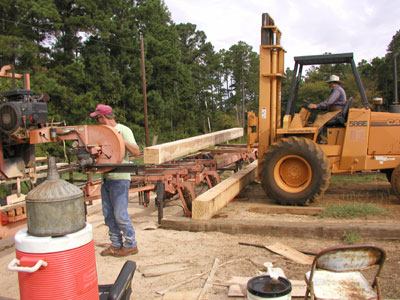
|
John is getting the sawmill ready as Victor moves the first timber cant into position.
We call these square timbers "cants" and I'm not real sure where
this came from! Possibly, "I cants tell what them there thangs are fer!"
oh well...
The red oak originally came from a tract of land east of Jasper Texas. All of the
red oak will be of southeast Texas origin and most will be supplied through our
contacts at G&S Lumber of Nacogdoches. Other oak logs for some of the bigger
timbers in the home will be sourced from Ronnie Borders, Inc. of Center Texas. I
am not sure what part of the southeast these logs originated in.
You can learn more about the different wood species we work with by following this
link, Wood Species.
|
|
We decided to work with red oak cants rather than logs because this reduces our
initial production time and we have been very pleased with the product supplied
by G&S for the red oak frame we built in Longview Texas. Getting good quality
red oak can be problematic but the material we have is consistently of good quality.
Mike is checking a cant to make sure it is properly aligned with the mill "table"
by using a carpenter's rule. We will resaw each timber cant to specific dimensions
of the frame.
|
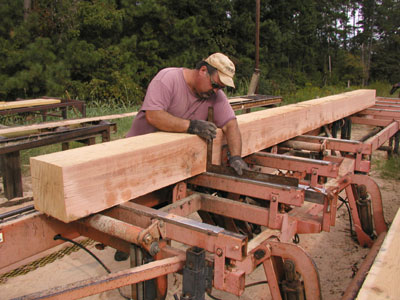
|
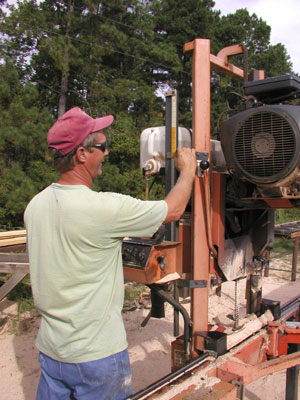
|
John works from a "cut list" that Tim and Robert produce once the
frame design has been approved and the construction drawings completed. The cut
list specifically defines the dimensions of each timber used in the frame. John
and his crew will cut each individual timber used in the home.
Here he is checking the saw depth to make sure it is properly set for the first
cut. We use a Wood Mizer band saw for all of our sawing needs.
|
|
The timber cant is correctly positioned on the saw table and the saw blade has been
set for the first cut. If you look closely you should notice that the timber cant
is not exactly square. Part of the sawing process is to square the timber so we
can accurately produce the joinery that will hold the frame together.
The "rough sawn" timber cant will be slightly larger than full dimension
so that the timber can be planned into exact tolerances.
|
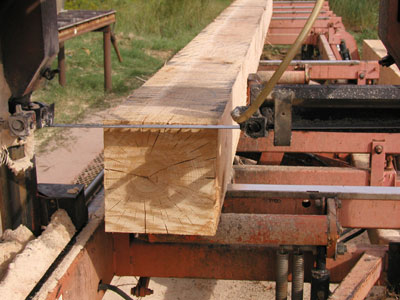
|
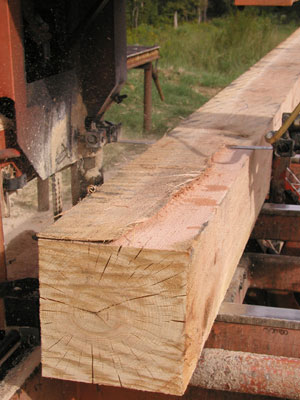
|
In this image you can see the saw blade just skimming the surface of the timber
cant. The material being removed will square this face of the timber with the saw
table.
The black marks you see on the oak is from a reaction of the naturally occurring
tannic acid in the oak with anything containing steel or iron. The tannic acid causes
the metal to oxidize leaving the black marks you see. When the joinery has been
cut and the timber receives a final finishing, the black marks will be removed leaving
a clean and smooth surface.
|
|
John continues down the length of the timber removing material and squaring the
cant. Notice that the timber cant does not move as it is secured to the table with
hydraulic clamps.
|
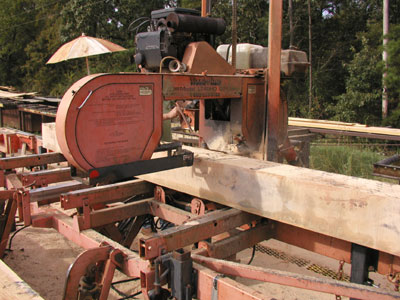
|
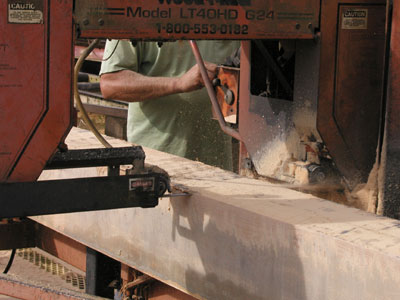
|
In this close up view, you can see how the saw blade cuts a thin line through the
timber cant. You should also notice that the sawmill is actually a "Bandsaw".
The thin blade of the saw produces very accurate cuts and removes very little material
in the process. Other types of saws remove much more material when the cut is made.
We call the width of the cut "Kerf". Smaller saw blades produce
smaller kerf and thus reduce the amount of wasted material.
|
|
As the layers are removed, Mike and Victor will pull the shavings off the timber
so that John can make his next pass.
John will work the timber like a diamond cutter works a stone, that is, he will
turn the timber several times making shallow cuts until it is the correct size.
This reduces the stresses in the timber and minimizes any warping that may occur
with green wood.
|
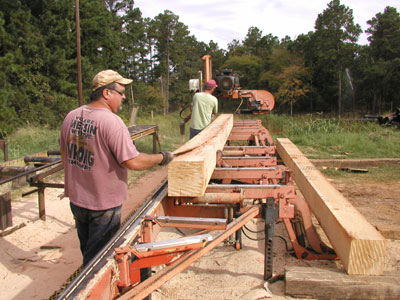
|
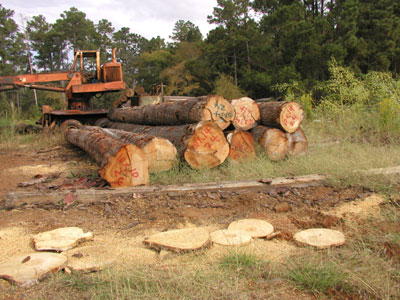
|
These logs were sourced from Ronnie Borders, Inc. and were specially purchased to
fabricate some of the longer oak timbers in the home. We are one of the very few
operations that can handle logs of this dimension and length.
Typically, we work with only a very few foresters in the area to source the logs
we use in timber frames. This is because our specifications are difficult to meet
and most loggers don't want to fool with us! But we pay a premium price for the
kind of select logs we need for the operation which helps us get what we need and
for the forester to make some additional money.
|
|
Most of these logs will be used to cut red oak cants that will eventually become
10"x14"x24' timbers. I counted the growth rings on these logs and the
average was about 63 rings or about 63 years old. There is a lot of red oak in managed
areas that is marked for commercial use. Red oak grows like weeds in east Texas.
It is not an endangered species.
These logs are scheduled for the sawmill in a couple of weeks.
|
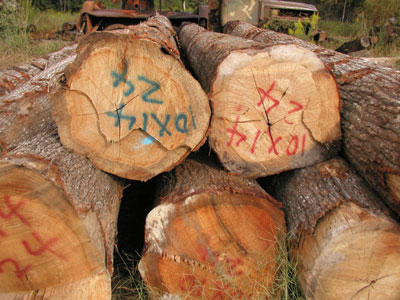
|
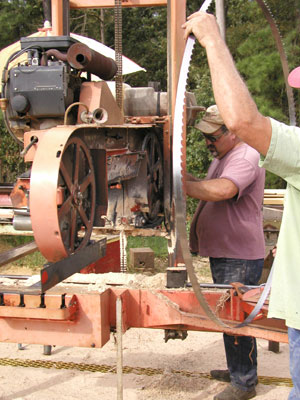
|
Oh the joys of working with red oak! Since the cellular structure of red oak is
so dense, John and the crew must change saw blades often to make sure they are producing
the best cuts they can. You can see how thin the circular blade is as John and Mike
prepare to install this new blade.
Once the blade is installed, John must calibrate the saw and table to ensure that
everything works according to specification. We will be sawing timber cants for
several days to cut all the timbers used in the frame.
The next stop for the newly cut timber cants is the timber sizer where they will
receive the first dimensional planning. We will see all that in the next report.
|